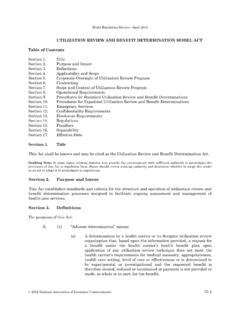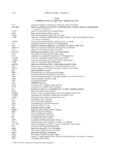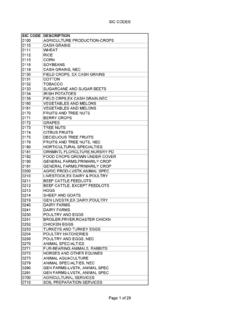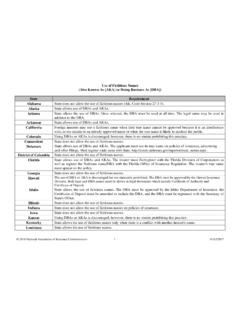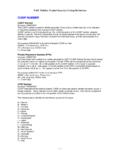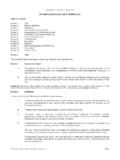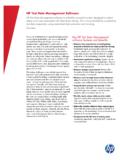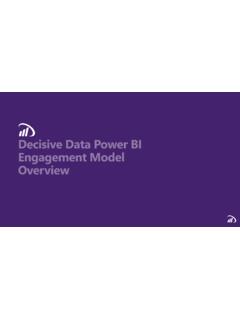Transcription of INSURANCE DATA SECURITY MODEL LAW Table of Contents …
1 PRELIMINARY WORKING AND DISCUSSION DRAFT 2016 National Association of INSURANCE Commissioners 1 Draft: 8/17/2016 (version 2) A new MODEL : INSURANCE data SECURITY MODEL Law Cybersecurity (EX) Task Force Comments are being requested on this draft by Friday, September 16, 2016. Comments should be sent by email to Sara Robben at INSURANCE data SECURITY MODEL LAW Table of Contents Section 1. Title Section 2. Purpose and Intent Section 3. Definitions Section 4. Information SECURITY Program Section 5. Investigation of a data Breach Section 6. Notification of a data Breach Section 7. Consumer Protections Following a data Breach Section 8. Power of Commissioner Section 9. Enforcement Section 10. Confidentiality Section 11. Penalties Section 12. Rules and Regulations Section 13. Severability Section 14. Effective Date Section 1. Title This act shall be known and may be cited as the INSURANCE data SECURITY Act. Section 2. Purpose and Intent Notwithstanding any other provision of law including [insert reference to state s general data SECURITY breach notification law], the purpose and intent of this Act is to establish the exclusive standards in this state for data SECURITY and investigation and notification of a data breach applicable to licensees, as defined in Section 3G.
2 This Act shall not be construed as superseding, altering, or affecting any statute, regulation, order or interpretation of law in this state, except to the extent that such statute, regulation, order or interpretation is inconsistent with the provisions of this Act and then only to the extent of the inconsistency. A state statute, regulation, order or interpretation is not inconsistent with the provisions of this Act if the protection such statute, regulation, order or interpretation affords any person is greater than the protection provided under this Act. This Act may not be construed to create or imply a private cause of action for violation of its provisions nor to curtail a private cause of action which would otherwise exist in the absence of this Act. Section 3. Definitions As used in this Act, the following terms shall have these meanings: A. Consumer means an individual, including but not limited to applicants, policyholders, insureds, beneficiaries, claimants, certificate holders and others whose personal information is in a licensee s possession, custody or control.
3 B. Consumer reporting agency has the same meaning as consumer reporting agency that compiles and maintains files on consumers on a nationwide basis in section 603(p) of the Fair Credit Reporting Act (15 1681a(p)). C. data breach means the unauthorized acquisition, release or use of personal information. PRELIMINARY WORKING AND DISCUSSION DRAFT 2016 National Association of INSURANCE Commissioners 2 The term data breach does not include the unauthorized acquisition, release or use of encrypted personal information if the encryption, process or key is not also acquired, released or used without authorization. D. Encrypted means the transformation of data into a form which results in a low probability of assigning meaning without the use of a protective process or key. E. Harm or inconvenience means any of the following or the reasonable likelihood thereof: (1) Identity theft; (2) Fraudulent transactions on financial accounts; or (3) Other misuse as defined by [insert state definition of misuse or comparable term, if applicable].
4 Drafting Note: Several states have defined the term misuse in state law and can refer to this in Section 3E(3). If a state does not have this term defined, they may consider either deleting that paragraph or defining misuse above using a definition similar to that of other states. For example, see 17-A Me. Rev. Stat. 905-A, which provides that A person is guilty of misuse of identification if, in order to obtain confidential information, property or services, the person intentionally or knowingly: A. Presents or uses a credit or debit card that is stolen, forged, canceled or obtained as a result of fraud or deception; B. Presents or uses an account, credit or billing number that that person is not authorized to use or that was obtained as a result of fraud or deception; or C. Presents or uses a form of legal identification that that person is not authorized to use. F. Information SECURITY program means the safeguards that a licensee uses to access, collect, distribute, process, protect, store, use, transmit, dispose of, or otherwise handle personal information.
5 G. Licensee means any person or entity licensed, authorized to operate, or registered, or required to be licensed, authorized, or registered pursuant to the INSURANCE laws of this state. H. Personal Information means: (1) A financial account number relating to a consumer, including a credit card number or debit card number, in combination with any SECURITY code, access code, password, or other personal identification information required to access the financial account; or (2) Information including: The first name or first initial and last name of a consumer in combination with: (a) The consumer s non-truncated social SECURITY number; (b) The consumer s driver s license number, passport number, military identification number, or other similar number on a government-issued document; (c) A user name or e-mail address, in combination with a password or SECURITY question and answer that would permit access to an online or financial account of the consumer; (d) Biometric data of the consumer that would permit access to financial accounts of the consumer.
6 (e) Any information of the consumer that the licensee has a legal or contractual duty to protect from unauthorized access or public disclosure; (f) The consumer s date of birth; (g) Information that the consumer provides to a licensee to obtain an INSURANCE product or service used primarily for personal, family, or household purposes from the licensee; PRELIMINARY WORKING AND DISCUSSION DRAFT 2016 National Association of INSURANCE Commissioners 3 (h) Information about the consumer resulting from a transaction involving an INSURANCE product or service used primarily for personal, family, or household purposes between a licensee and the consumer; (i) Information the licensee obtains about the consumer in connection with providing an INSURANCE product or service used primarily for personal, family, or household purposes to the consumer; or (j) A list, description, or other grouping of consumers (and publicly available information pertaining to them), that is derived using the information described in Section 3H(2)(g) through (i), that is not publicly available.
7 (3) Any of the data elements identified in Section 3H(2)(a) through (f) when not in connection with the consumer s first name or initial and last name, if those elements would be sufficient to permit the fraudulent assumption of the consumer s identity or unauthorized access to an account of the consumer. (4) Any information or data except age or gender, that relates to: (a) The past, present or future physical, mental or behavioral health or condition of a consumer; (b) The provision of health care to a consumer; or (c) Payment for the provision of health care to a consumer. The term personal information does not include publicly available information that is lawfully made available to the general public and obtained from federal, state, or local government records; or widely distributed media. I. Third-party service provider means a person or entity that contracts with a licensee to maintain, process, store or otherwise have access to personal information under the licensee s possession, custody or control.
8 Section 4. Information SECURITY Program A. Implementation of an Information SECURITY Program Commensurate with the size and complexity of the licensee, the nature and scope of the licensee s activities and the sensitivity of the personal information in the licensee s possession, custody or control, each licensee shall develop, implement, and maintain a comprehensive written information SECURITY program that contains administrative, technical, and physical safeguards for the protection of personal information. The licensee shall document, on an ongoing basis, compliance with its information SECURITY program. B. Objectives of Information SECURITY Program A licensee s information SECURITY program shall be designed to: (1) Protect the SECURITY and confidentiality of personal information; (2) Protect against any anticipated threats or hazards to the SECURITY or integrity of the information; (3) Protect against unauthorized access to or use of personal information, and minimize the likelihood of harm or inconvenience to any consumer; and (4) Define and periodically reevaluate a schedule for retention of personal information and a mechanism for its destruction when no longer needed.
9 PRELIMINARY WORKING AND DISCUSSION DRAFT 2016 National Association of INSURANCE Commissioners 4 C. Risk Assessment The licensee shall: (1) Designate an employee or employees responsible for the information SECURITY program; (2) Identify reasonably foreseeable internal or external threats that could result in unauthorized access, transmission, disclosure, misuse, alteration or destruction of personal information or personal information systems; (3) Assess the likelihood and potential damage of these threats, taking into consideration the sensitivity of the personal information; (4) Assess the sufficiency of policies, procedures, personal information systems and other safeguards in place to manage these threats, including consideration of threats in each relevant area of the licensee s operations, including: (a) Employee training and management; (b) Information systems, including network and software design, as well as information processing, storage, transmission, and disposal.
10 And (c) Detecting, preventing, and responding to attacks, intrusions, or other systems failures; and (5) Implement information safeguards to manage the threats identified in its assessment, and regularly assess the effectiveness of the safeguards key controls, systems, and procedures. D. Risk Management The licensee shall, at a minimum: (1) Design its information SECURITY program to mitigate the identified risks, commensurate with the sensitivity of the information, as well as the complexity and scope of the licensee s activities, based on generally accepted cybersecurity principles, including the following SECURITY measures, as appropriate: (a) Place access controls on information systems, including controls to authenticate and permit access only to authorized individuals and controls to prevent the unauthorized acquisition, release or use of personal information to or by employees or unauthorized individuals outside of the licensee; (b) Restrict access at physical locations containing personal information, only to authorized individuals.
